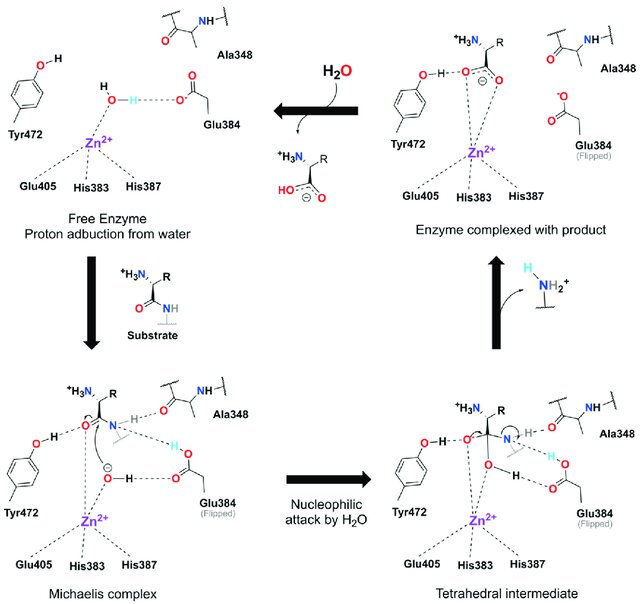

1.Mechanism
The mechanism of action involves the cleavage of amino acids from the N-terminus of peptide chains.

Figure 1. Action of aminopeptidases removing the terminal amino acid residues on a polypeptide substrate (having n residues). Red arrows show the peptide bonds to be cleaved[1].
i.Catalytic Mechanism of Aminopeptidases
Aminopeptidases typically function as monozinc enzymes, where a zinc ion plays a pivotal role in their catalytic activity. The enzymatic mechanism of aminopeptidases involves the coordination of the zinc ion with water molecules and specific amino acid residues within the active site, facilitating the hydrolysis of peptide bonds[2].

Figure 2. Aminopeptidase M (AMP) proposed catalytic mechanism. Starting from the free enzyme complexed with the structural water towards the activated state by a proton abduction from the water by the Glu384. Upon substrate binding the hydroxyl group nucleophili Dashed lines represent interactions and are for illustration purposes only, in the sense that angles and distances are not proportionally realists[3].
ii.Role of Conserved Residues and Motifs
The catalytic efficiency and specificity of aminopeptidases are significantly influenced by conserved residues and motifs within their structure. For instance, the M1 family of vertebrate aminopeptidases, including aminopeptidase B, features evolutionarily conserved tyrosines that are crucial for their enzymatic mechanism[4]. Similarly, in aminopeptidase A (APA), residues Arg368 and Arg386 within the S2' subsite play a vital role in inhibitor binding and catalysis. These arginines establish interactions with the P2' and P1' residues of APA inhibitors, contributing to their inhibitory potency. Additionally, Arg368 is essential for maintaining the structural integrity of the GAMEN motif, a sequence involved in exopeptidase specificity and optimal substrate positioning[2].
iii.Structural Insights and Conformational Changes
The structural organization and conformational flexibility of aminopeptidases are key factors in their catalytic mechanism. For example, endoplasmic reticulum aminopeptidase 1 (ERAP1) exhibits at least two distinct conformations, with the C-terminal domain IV being either proximal or distal to the active site domain II. Interdomain interactions, particularly electrostatic interactions between domains II and IV, are critical for the enzyme's catalytic efficiency and allosteric behavior. Mutations disrupting these interactions can significantly reduce catalytic activity and alter kinetic properties[5].
Furthermore, insulin-regulated aminopeptidase (IRAP) demonstrates significant active-site plasticity, allowing it to accommodate a wide variety of substrates. Ligand-induced conformational changes in IRAP result in a novel enzyme conformation that excludes external solvent access to the catalytic center, highlighting the enzyme's substrate permissiveness[6].
References
1. Mótyán, J., F. Tóth, and J. Tözsér, Research Applications Of Proteolytic Enzymes In Molecular Biology. Biomolecules, 2013. 3: p. 923-942.
2. Couvineau, P., et al., Structural insight into the catalytic mechanism and inhibitor binding of aminopeptidase A. Biochem J, 2020. 477(21): p. 4133-4148.
3. Ferreira, G., et al., Inhibition of Porcine Aminopeptidase M (pAMP) by the Pentapeptide Microginins. Molecules, 2019. 24.
4. Cadel, S., et al., The M1 family of vertebrate aminopeptidases: role of evolutionarily conserved tyrosines in the enzymatic mechanism of aminopeptidase B. Biochimie, 2015. 109: p. 67-77.
5. Stamogiannos, A., et al., Critical Role of Interdomain Interactions in the Conformational Change and Catalytic Mechanism of Endoplasmic Reticulum Aminopeptidase 1. Biochemistry, 2017. 56(10): p. 1546-1558.
6. Mpakali, A., et al., Ligand-Induced Conformational Change of Insulin-Regulated Aminopeptidase: Insights on Catalytic Mechanism and Active Site Plasticity. J Med Chem, 2017. 60(7): p. 2963-2972.